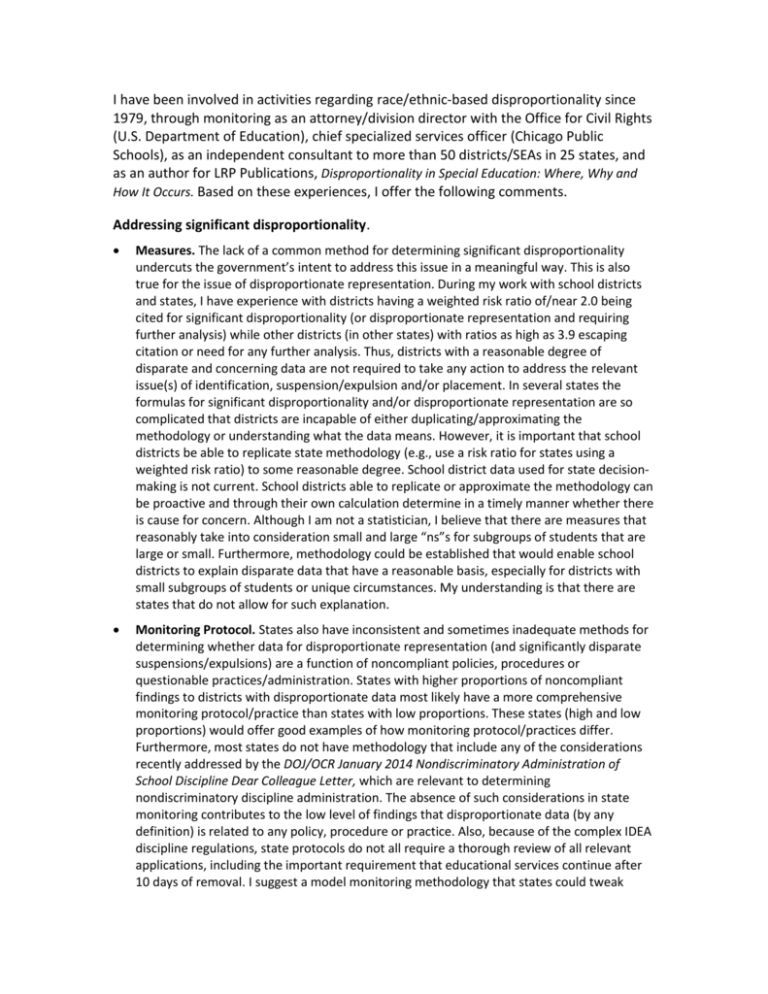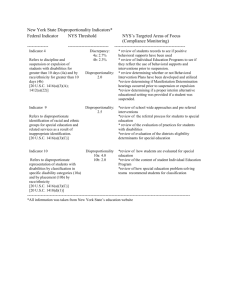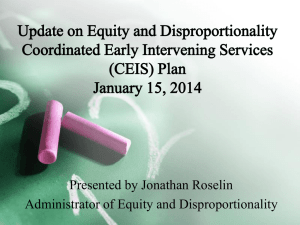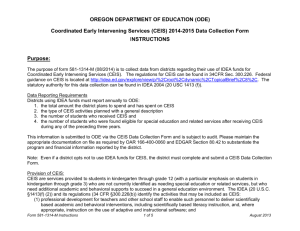dispro%20comments1fr..
advertisement

I have been involved in activities regarding race/ethnic-based disproportionality since 1979, through monitoring as an attorney/division director with the Office for Civil Rights (U.S. Department of Education), chief specialized services officer (Chicago Public Schools), as an independent consultant to more than 50 districts/SEAs in 25 states, and as an author for LRP Publications, Disproportionality in Special Education: Where, Why and How It Occurs. Based on these experiences, I offer the following comments. Addressing significant disproportionality. Measures. The lack of a common method for determining significant disproportionality undercuts the government’s intent to address this issue in a meaningful way. This is also true for the issue of disproportionate representation. During my work with school districts and states, I have experience with districts having a weighted risk ratio of/near 2.0 being cited for significant disproportionality (or disproportionate representation and requiring further analysis) while other districts (in other states) with ratios as high as 3.9 escaping citation or need for any further analysis. Thus, districts with a reasonable degree of disparate and concerning data are not required to take any action to address the relevant issue(s) of identification, suspension/expulsion and/or placement. In several states the formulas for significant disproportionality and/or disproportionate representation are so complicated that districts are incapable of either duplicating/approximating the methodology or understanding what the data means. However, it is important that school districts be able to replicate state methodology (e.g., use a risk ratio for states using a weighted risk ratio) to some reasonable degree. School district data used for state decisionmaking is not current. School districts able to replicate or approximate the methodology can be proactive and through their own calculation determine in a timely manner whether there is cause for concern. Although I am not a statistician, I believe that there are measures that reasonably take into consideration small and large “ns”s for subgroups of students that are large or small. Furthermore, methodology could be established that would enable school districts to explain disparate data that have a reasonable basis, especially for districts with small subgroups of students or unique circumstances. My understanding is that there are states that do not allow for such explanation. Monitoring Protocol. States also have inconsistent and sometimes inadequate methods for determining whether data for disproportionate representation (and significantly disparate suspensions/expulsions) are a function of noncompliant policies, procedures or questionable practices/administration. States with higher proportions of noncompliant findings to districts with disproportionate data most likely have a more comprehensive monitoring protocol/practice than states with low proportions. These states (high and low proportions) would offer good examples of how monitoring protocol/practices differ. Furthermore, most states do not have methodology that include any of the considerations recently addressed by the DOJ/OCR January 2014 Nondiscriminatory Administration of School Discipline Dear Colleague Letter, which are relevant to determining nondiscriminatory discipline administration. The absence of such considerations in state monitoring contributes to the low level of findings that disproportionate data (by any definition) is related to any policy, procedure or practice. Also, because of the complex IDEA discipline regulations, state protocols do not all require a thorough review of all relevant applications, including the important requirement that educational services continue after 10 days of removal. I suggest a model monitoring methodology that states could tweak (with OSEP review) to ensure that policies, procedures and practices are reviewed in a meaningful way to truly identify relationships between administration and outcomes, including consideration of the DOJ/OCR Dear Colleague Letter. I recognize that this issue requires difficult and complex monitoring activities but they should be reasonably comprehensive to root out the basis of administrative actions that trigger and reinforce disparate outcomes. Public Notice. States are not required to provide public notice on websites regarding school district quantitative data showing either significant disproportionality or the basis of disproportionate representation that requires further analysis. Very few states publish the data voluntarily, which makes it difficult if not impossible for this data to be accessed by school district personnel and public stakeholders. Encouraging greater voluntary use of funds for CEIS in LEAs showing significant disparities (but no determination of significant disproportionality) by race and ethnicity in the rates of identification of children for special education, including identification by disability category, educational placements, and disciplinary actions. The exclusion of students with disabilities from the use of CEIS funds, which operationally excludes them from universal access to a multi-tiered system of supports, is problematic. Although CEIS funding is proactive in nature, addressing students who do not have IEPs, it has no benefit for the subgroup of students with IEPs who are victims of the identified disproportionality. For identification, placement and discipline, there is an advantage of using CEIS funds in a way that is inclusive rather than exclusive. Students with IEPs in disparate racial/ethnic subgroups would benefit from many interventions provided with their nondisabled peers, the outcomes of which could reduce restrictive placements and suspensions/expulsions, and result in a termination of disability labels. Focusing solely on students without IEPs for these issues reduces scarce IDEA funding for this population of students when they would benefit from a multi-tiered approach with nondisabled peers, and for special educators who would benefit from training alongside general and bilingual educators. The guidance that has been offered by OSEP regarding the use of CEIS funds for students with IEPs relies on complex record keeping and subtle guidance application that makes it very difficult to implement, and actually discourages implementation. To the extent that this issue is impossible to address further outside of IDEA reauthorization, I suggest it be addressed as part of that future process. Encouraging more effective, targeted use of funds for CEIS to address significant disproportionality in both districts required to use funds for CEIS (as result of a determination of significant disproportionality) and districts choosing to use funds for CEIS. In my experience, it takes many years to positively impact data showing a reduction in significant disproportionality – especially for large districts. One way to address this issue as well as to encourage/require more effective and targeted use of funds for CEIS is to require progress monitoring data for students benefiting from CEIS (pre and post) to determine if the designed activities have the anticipated impact for targeted students during the school year in question, e.g., reduced disparate rates for suspensions/expulsions, identification, placements. By using progress monitoring data (standardized in some way) CEIS activities having the greatest effect could be highlighted and used to change practices elsewhere. Also, states would be able to take into consideration and reinforce the practices of districts that show progress for targeted subgroups during a school year yet still have districtwide racial/ethnic disparities.











